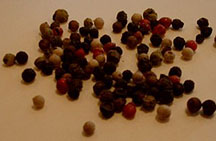
Other articles you might enjoy:
Make the most of culinary herbs and spices.
All About Peppercorns
by Sandra Bowens

Chances are, you have what is considered the world's most important spice right there on your dining table. You have probably sprinkled pepper on something today. What would we do without peppercorns?
That question has driven the spice trade since well before the Middle Ages. Great fortunes of entire cities, like Venice and Portugal, have been won and lost due to early monopolies on peppercorns and other Oriental spices. The world was explored in search of spices, especially pepper. The first merchant marine boats were loaded with peppercorns.
Before the nineteenth century, pepper was regarded as a luxury for the upper classes. Often scarce, it was as valuable as money. In medieval times, peppercorns were legal tender.
Today, peppercorns are widely available and affordable. Nearly every culture uses both black and white pepper in the preparation of savory dishes. Pepper is an excellent seasoning for virtually every food except sweets although the German cookie pfeffernusse is flavored with the hot spice.
Peppercorns are the fruit of Piper nigrum, an evergreen climbing vine native to the jungles of India's Malabar Coast. As demand for pepper grew, cultivation spread. India continues to be a major producer but the Indonesian islands and Malaysia also make great contributions to world trade.
Black, white and green peppercorns are all products of the same plant but each is harvested and handled differently. The berries grow in spikey clusters on vines that reach 30 feet or more. The vines are cultivated on small plots that must be tended to carefully. The vine is trained to grow onto support posts, regular weeding and fertilizers are mandatory and shade from the sun is sometimes necessary. A vine will not yield a crop until after the third year and does not go into full production until around the seventh year. The clustered spikes of perhaps 50 berries are hand-picked at just the right time for the desired black, white or green peppercorns.
For black pepper the clusters are plucked when not quite ripe then left in piles to ferment. After a few days, the individual berries are spread out and left to dry in the sun for two or three more days or until they are shriveled and nearly black. The finest black peppercorns are said to be Tellicherry from India because they are larger and the most flavorful.
White pepper is derived from the fully ripened berries that are just about to turn red. After harvest the clusters are packed in bags and soaked in water, sometimes flowing water, for more than a week. This softens the outer coating, or pericarp, so that it may be removed to reveal gray centers. The peppercorns are then spread out to dry in the sun where they become naturally bleached to white. Sarawak white peppercorns from Malaysia are said to be the finest due to careful handling and processing. A close second are the Indonisian Muntok type.
Green peppercorns are harvested when the berry is immature and then packed in brine. They offer a fresher flavor and less pungency than black or white pepper. Dried green peppercorns are also available alone or combined in four-pepper mixtures.
The pink peppercorn, usually the fourth component in these blends, is not actually a member of the pepper family although it is often marketed as such. This faintly sweet spice from Reunion Island does enhance the flavor of the other true peppers.
Both black and white peppers have a place in every kitchen. Black pepper has a biting, hot flavor suitable to seasoning an immense variety of foods. White pepper is more subtle in heat and more practical in lighter colored dishes where black specks would be unappealing. Used in combination, black, white and green peppercorns offer a great range of tastes.
Whole peppercorns will provide flavor to recipes without adding a great deal of heat. Just be sure to remove them so that no one suffers from biting into one. Add pepper toward the end of cooking to prevent it from turning harsh.
Pepper is sold in a confusing array of "grinds." Mesh size is a reference point for each grind. This refers to the size of a screen sifter that the ground product will fall through; the higher the number, the finer the grind. Words are much simpler and more descriptive. Cracked pepper is similar to barely broken peppercorns while a coarse grind has the texture of Kosher salt. Table grind, or shaker grind, is what you find in a shaker next to the salt on most tables. Fine grinds are near dust. White pepper is often sold in a fine grind.
As with all spices, it is preferable to grind your own pepper just before using. Ground pepper loses its flavor quickly and an unethical vendor may add other, less expensive ingredients to the mix. Pepper grinders are widely available and offer you the choice of mesh size with the flick of the wrist. Look for a wooden grinder with metal blades for the longest life.
Skillet Steamed Swiss Chard
1 large bunch Swiss chard
2 teaspoons olive oil
Salt and freshly ground black pepper
Extra virgin olive oil
Balsamic vinegar
Remove tough stems from the chard. Wash well but don't worry about drying it off. Chop the leaves roughly and set aside.
Heat the 2 teaspoons of olive oil in a wide non-stick skillet over medium-high heat until very hot but not smoking. Carefully add the chopped chard with a bit of salt and pepper; toss well. Cover the skillet and allow the chard to steam for a minute or two. Stir and replace the lid, steaming a few minutes more. Season with a bit more salt and pepper before transferring to a serving dish.
Serve warm, passing the extra virgin olive oil, balsamic vinegar and pepper grinder so that each diner may dress the chard to personal taste.
Here's one that's full of our favorite recipes because we wrote the book! It is also full of information, helpful hints and ideas for using herbs and spices in your kitchen.
Start with coriander, cumin, mustard, cayenne pepper, and turmeric, work a little magic and finish with more than fifty different, delicious Indian dishes.
Healthy cooking at its finest, and tastiest.
Madhur Jaffrey, everybody's favorite Indian chef, shows us how to prepare authentic foods fast.





